2022年中考英语复习动词时态之一般现在时 课件(共65张PPT)
文档属性
| 名称 | 2022年中考英语复习动词时态之一般现在时 课件(共65张PPT) | 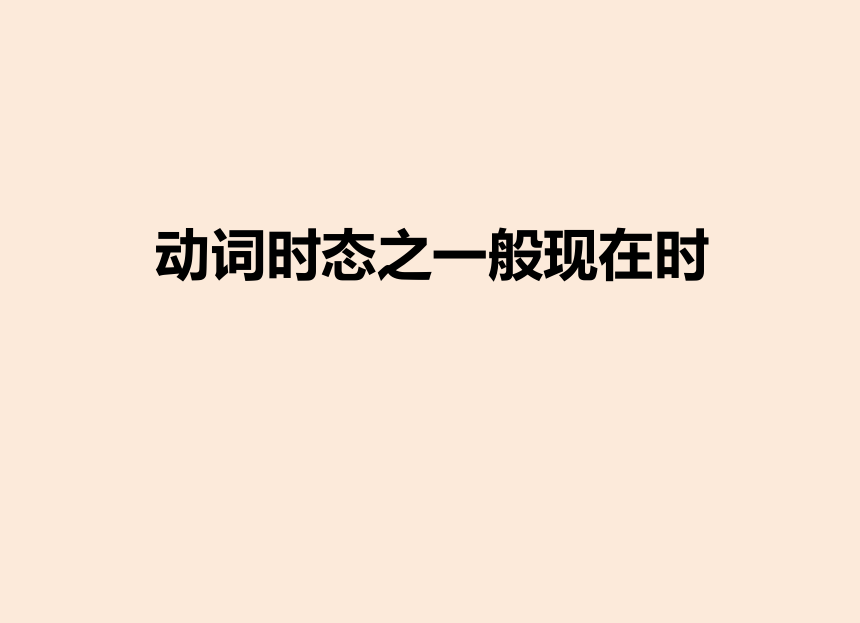 | |
| 格式 | zip | ||
| 文件大小 | 2.4MB | ||
| 资源类型 | 教案 | ||
| 版本资源 | 通用版 | ||
| 科目 | 英语 | ||
| 更新时间 | 2021-12-31 07:14:42 | ||
图片预览

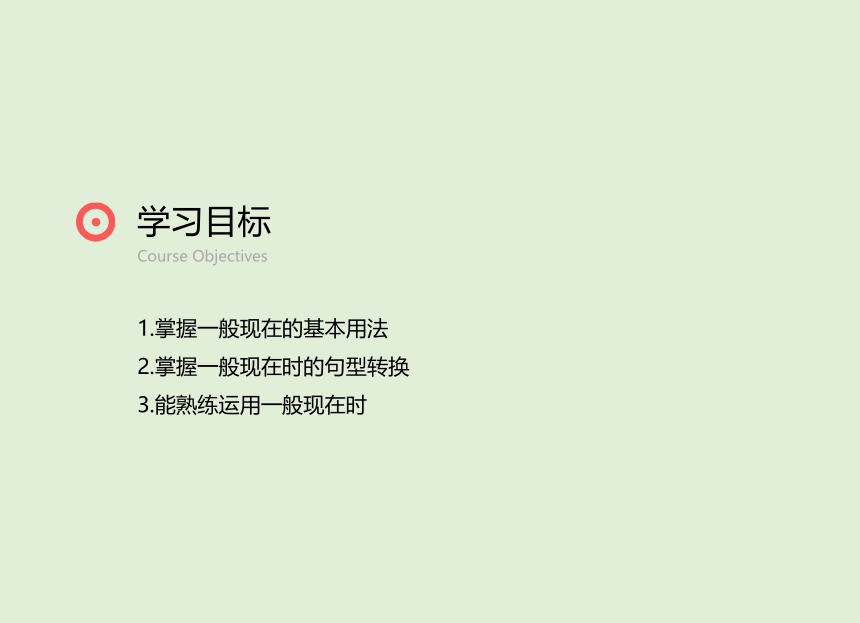
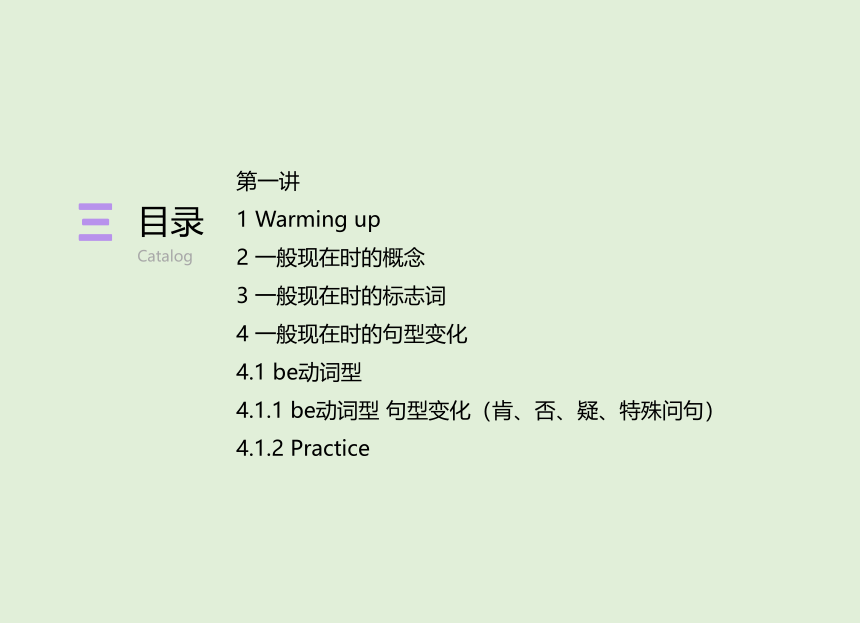
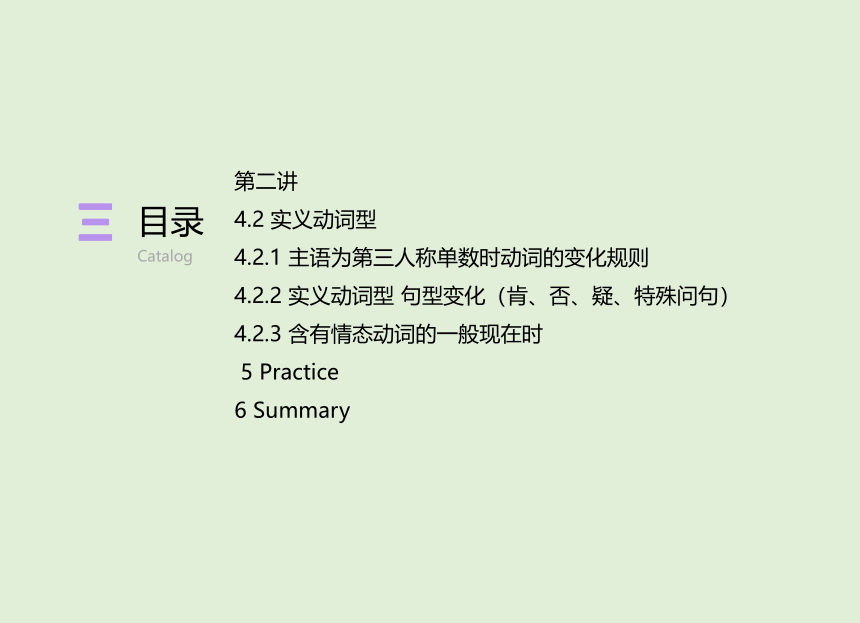
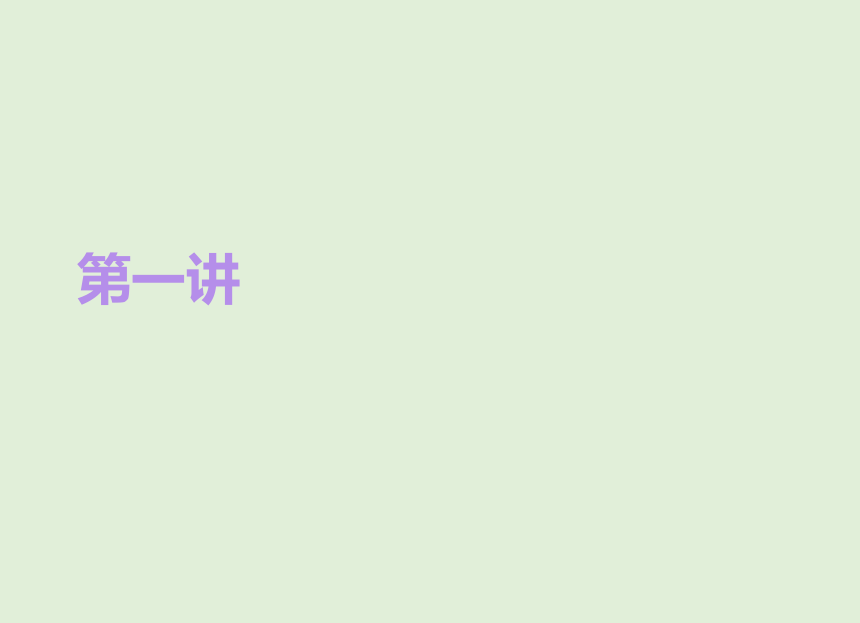
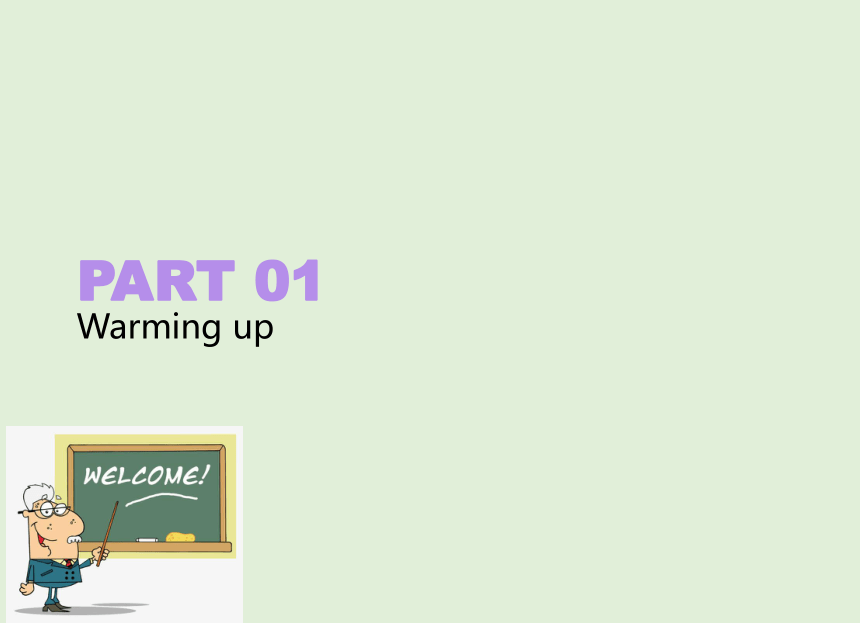
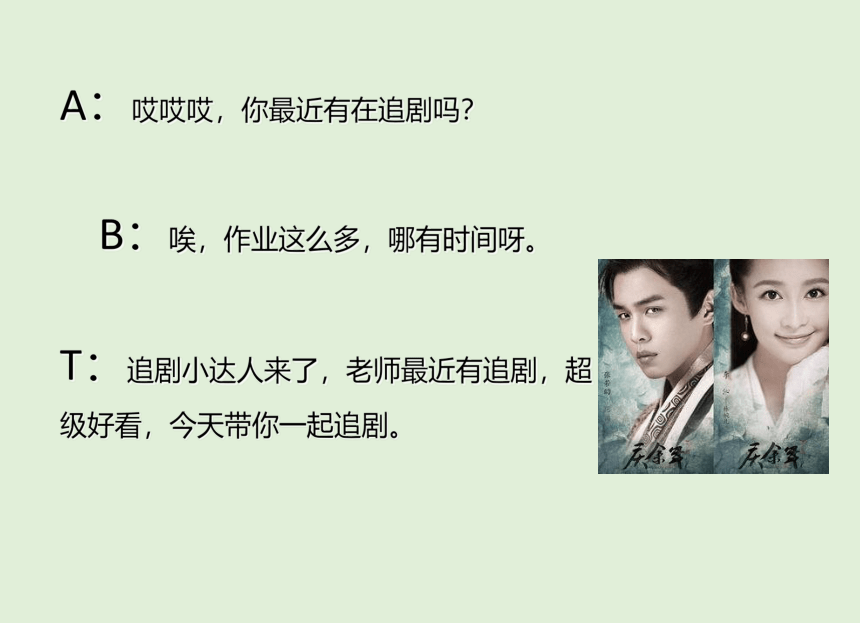
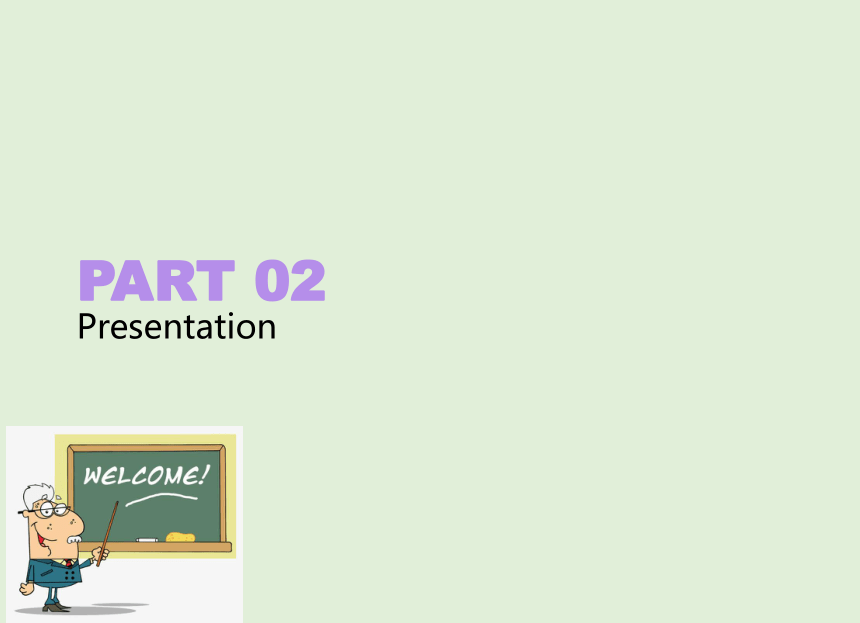
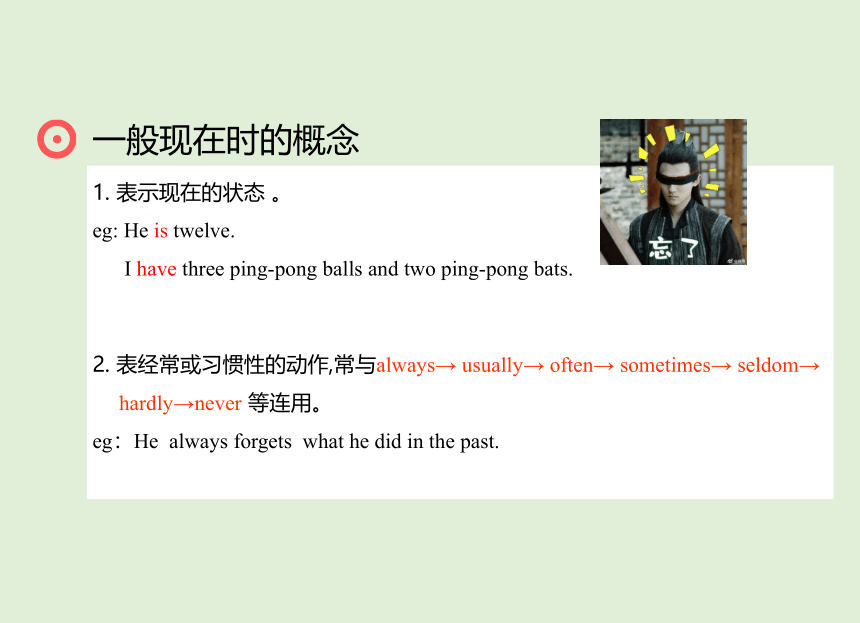
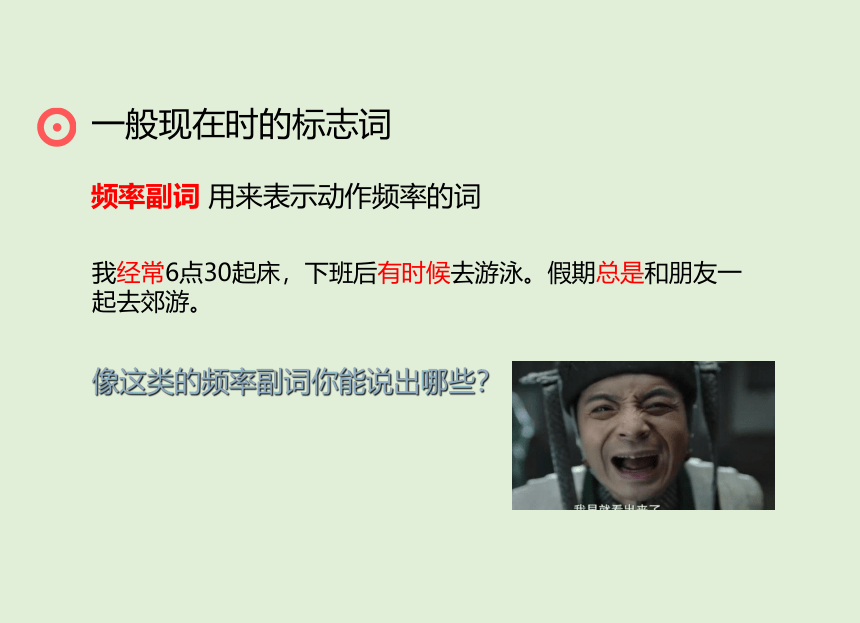
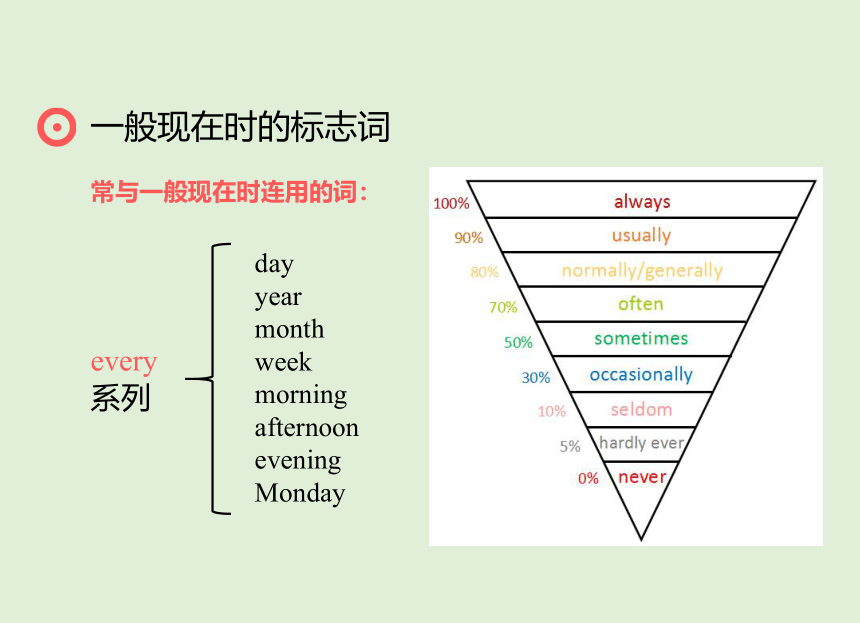

文档简介
(共65张PPT)
动词时态之一般现在时
学习目标
Course Objectives
1.掌握一般现在的基本用法
2.掌握一般现在时的句型转换
3.能熟练运用一般现在时
目录
Catalog
第一讲
1 Warming up
2 一般现在时的概念
3 一般现在时的标志词
4 一般现在时的句型变化
4.1 be动词型
4.1.1 be动词型 句型变化(肯、否、疑、特殊问句)
4.1.2 Practice
目录
Catalog
第二讲
4.2 实义动词型
4.2.1 主语为第三人称单数时动词的变化规则
4.2.2 实义动词型 句型变化(肯、否、疑、特殊问句)
4.2.3 含有情态动词的一般现在时
5 Practice
6 Summary
第一讲
PART 01
Warming up
A:哎哎哎,你最近有在追剧吗?
B:唉,作业这么多,哪有时间呀。
T:追剧小达人来了,老师最近有追剧,超级好看,今天带你一起追剧。
PART 02
Presentation
1. 表示现在的状态 。
eg: He is twelve.
I have three ping-pong balls and two ping-pong bats.
2. 表经常或习惯性的动作,常与always→ usually→ often→ sometimes→ seldom→
hardly→never 等连用。
eg:He always forgets what he did in the past.
一般现在时的概念
频率副词 用来表示动作频率的词
我经常6点30起床,下班后有时候去游泳。假期总是和朋友一起去郊游。
像这类的频率副词你能说出哪些?
一般现在时的标志词
一般现在时的标志词
常与一般现在时连用的词:
every系列
day
year
month
week
morning
afternoon
evening
Monday
Li Ping is always late for school on Monday.
Tom is never late for school in the morning.
The little girl seldom goes out.
I am busy with this work everyday.
Sometimes we go to the cinema.
Practice
划出句子中的频率副词
3. 表示主语具备的喜好、性格和能力等。
eg: He is vety silent.
Tom likes beef, but he doesn't like chicken.
4.表示客观真理
e.g. There are seven days in a week.
The moon moves round the earth.
一般现在时的概念
be 动词的一般现在时
陈述句: He is from Qing guo.
否定句:He is not a normal person.
一般疑问句:Is he a robot
肯定回答 :Yes,he is .
否定回答 :No,he isn't .
特殊疑问句:Where is he from
你可以总结一下一般现在时的句型结构吗?
be 动词的一般现在时句型结构
肯定句:主语+be+其他.(主+系+表)
否定句:主语+be+not+其他.
一般疑问句:Be+主语+其他?
回答:Yes, 主语+be.\ No, 主语+be+not.
特殊疑问句:特殊疑问词+be动词型一般疑问句?
我(I)用am, 你(You)用 are
is 用于he、she、it
单数 is,复数 are
缩写
I am = I’m you are= you’re
he is = he’s she is = she’s
it is =it’s we are =we’re
they are =they’re
be 动词使用小口诀:
I. 用适当的be动词填空
1. I a boy. you a boy No, I not.
2. The girl Jack’s sister.
3. your brother in the classroom
4. Who I
5. The books on the desk.
6. My sister’s name Nancy.
be 动词练习题
答案
1.am, Are, am
2. is
3. is
4. am
5. are
6. is
be 动词练习题
II. 按要求写句子
1. She is in a blue dress.(变否定句)
She_______ _____ a blue dress.
2. I am from America. (变一般疑问句)
____ _____ from America
3. Are the storybooks very interesting (做否定回答)
No,_______ ________.
4. His parents are both teachers. (变一般疑问句)
_____ ____ ___________ both teachers
be 动词练习题
答案
1. isn't in
2. Are you
3. they aren't
4. Are his parents
be 动词练习题
II. 按要求写句子
5. Tom is a good boy at home.
_____________________________________________________(否定句)
_________________________________________________(一般疑问句)
______________________________________________(肯定/否定回答)
6. My birthday is on October 1st.
______________________________________________________(否定句)
_________________________________________________(一般疑问句)
______________________________________________(肯定/否定回答)
be 动词练习题
答案
5. Tom isn't a good boy at home.
Is Tom a good boy at home
Yes, he is. /No, he isn't.
6. My birthday isn't on October 1st.
Is your birthday on October 1st?
Yes, it is. / No, it isn't.
be 动词练习题
II. 按要求写句子
7. Lucy is under the tree.
_____________________________________________________(否定句)
_________________________________________________(一般疑问句)
______________________________________________(肯定/否定回答)
8. My telephone number is 555-6437.
_____________________________________________________(否定句)
_________________________________________________(一般疑问句)
______________________________________________(肯定/否定回答)
be 动词练习题
答案
7. Lucy isn't under the tree.
Is Lucy under the tree
Yes, she is. / No, she isn't.
8. My telephone number isn't 555-6437.
Is your telephone number 555-6437
Yes, it is. / No, it isn't.
be 动词练习题
第二讲
动词原形;如: like
第三人称单数动词形式;如: likes
主语 + (+其它)。
行为动词原形
实义动词的单数第三人称形式
{
如:We study English.我们学习英语。
He wants to know the old things.
一般现在时实义动词型
实义动词
什么叫实义动词?
实义动词是指表示有具体意思的动词,也叫行为动词。
如: like(喜欢), eat(吃), live(居住), have(有), run(跑) 等等。
实义动词占英语中动词的绝大多数。
注意:我们已学过的be 动词可译成“是”, 有时译成“成为”,有时则没有具体意思如: “She is tall.”这句译成: “她很高”。故be 动词不属于实义动词。
什么是第三人称单数???
一、人称代词he, she, it是第三人称单数。
如:He likes watching TV. 他喜欢看电视。
She has lunch at twelve. 她十二点吃午餐。
It looks like a cat. 它看起来像只猫。
二、单个人名、地名或称呼作主语;是第三人称单数。
如:Han Mei looks like her mother.
韩梅看起来像她的母亲。
Beijing is in China. 北京在中国。
Uncle Wang often makes cakes. 王叔叔经常做蛋糕。
三、不定代词someone, somebody, nobody, everything, something等及指示代词this, that作主语时,是第三人称单数。
如: Everyone is here. 每个人都在这。
This is a pen. 这是一支钢笔。
That is an eraser. 那是一个橡皮。
四、不可数名词作主语时为第三人称单数。
如: The milk is in the glass. 牛奶在杯子里。
The bread is very small. 面包非常小。
五、当数字或字母作主语时,看作第三人称单数。
如: "6" is a lucky number.6是一个幸运数字。
"I" is a letter. I是一个字母。
She He
I they
Tom my tesacher
Beijing An apple
The book These trees
Lucy You
火眼金睛——谁是第三人称单数
根据下面的三条内容,你能发现变化规则吗?
1. work—works play—plays sing—sings
2. pass—passes fix—fixes teach—teaches
wash—washes do—does go—goes
3. study—studies carry—carries fly—flies
动词第三人称单数形式的变化规则
1、一般情况,在词尾加 -s
2、以s, x, ch, sh,o,结尾的动词,在词尾加 -es
3、以辅音字母加y结尾的动词, 把y变成 i,再加es
备注:有些词要特殊记忆have—has
读音:清辅音后发/s/,浊辅音和元音发/z/,[s] [t ] [ ] [z]等音素结尾的发[iz]音。
实义动词第三人称单数形式的变化规则
写出下列动词的第三人称单数形式:
wash ______ guess______ study______
finish______ do ______ carry ______
stop ______ see ______ drive ______
have ______ stay ______ give ______
ring ______ dance______ let ______
小试身手
答案
washes guesses studies
finishes does carries
stops sees drives
has stays gives
rings dances lets
小试身手
肯定句:主(非三单)+动词(原型)+其他.(主+谓+宾)
eg:I like reading books.
否定句:主+don’t+动词原形+其他.
eg:I _________________ (like) reading books.
一般现在时实义动词型 句型结构
助动词 do 的三单does 否定形式 don't、doesn't
一般疑问句:Do +主语(非三单)+动词原形+其他?
eg:____________________ (like) reading books
回答: Yes, 主语+do.\ No, 主语+don’t.
特殊疑问句:(特殊疑问句 + 一般疑问句?)
______ + __________ you ______ (划线部分提问)
一般现在时实义动词型 句型结构
助动词 do 的三单does 否定形式 don't、doesn't
肯定句:主(三单)+ 动词(三单)+其他.
eg:He likes drinking on the street.
否定句:主(三单)+ doesn’t(三单)+动词原形+其他.
eg:He _________________ (like) drinking on the street.
一般现在时实义动词型 句型结构
助动词 do 的三单does 否定形式 don't、doesn't
一般疑问句:Does(三单)+主语+动词原形+其他?
eg:____________________ (like) drinking on the street
回答: Yes, 主语+does. \ No, 主语+doesn’t.
特殊疑问句:(特殊疑问句 + 一般疑问句?)
______ + __________ he ______ (划线部分提问)
一般现在时实义动词型 句型结构
助动词 do 的三单does 否定形式 don't、doesn't
实义动词的一般现在时用法小结
谓语动词是实义动词时, 其一般现在时的谓语动词形式有两种——第三人称单数或原形。其否定句和疑问句要借助于does或do来帮助构成。
助动词的用法小结
一、什么是助动词?
在英语中,助动词本身没有意义,只是帮助实义动词完成某些语法功能,如构成否定句、疑问句、简略答语等。
助动词主要有be,do,have等。
本节课我们主要探究do的基本用法。
二. 助动词do的基本用法
do有三种形式:
原形
现在式第三人称单数
过去式(这里只需对此有基本了解即可)
do的基本用法:
构成否定句
构成一般疑问句及回答
构成特殊疑问句
原形
肯定式: do
否定式: do not
缩略否定式: don’t
用法:do用在第一人称单复数、第二人称单复数和第三人
称复数做主语,且时态为一般现在时的句子中。
现在式第三人称单数
肯定式: does
否定式: does not
缩略否定式: doesn’t
用法:does用在第三人称单数做主语,且时态为一
般现在时的句子中。
注意:当does出现时,句子中用动词原形。
EXERCISES
1. What color ( ) you like best
A. do B. does C. are
2. What food ( ) she like best
A. do B. does C. is
3. Dos she ( ) apples or pears
A. likes B. like C. liked
4. —Do you like red
— ( ).
A. Yes, I don’t. B. Yes, I do.
C. No, I do. D. No, I doesn’t.
5. Do you have to go now
肯定回答:
_________________________________________
否定回答:
_________________________________________
6. She has two brothers.
变为一般疑问句并做肯定回答:
_________________________________________
7. They have a football.
对划线部分提问:
_________________________________________
ANSWERS:
1-4 A B B B
5. Yes, I do. No, I don’t.
6. Does she have two brothers Yes, she does.
7. What do they have
肯定句:主+ 情态动词+动词(原型)+其他.
eg:They can carry the box.
否定句:主+情态动词+not+动词原形+其他.
eg:They ________ _______ the box.
一般现在时(含情态动词)句型结构
一般疑问句:情态动词+主语+动词原形+其他?
eg:________ _______ carry the box
回答: Yes, 主语+情态动词.\ No, 主语+情态动词 +not.
一般现在时(含情态动词)句型结构
1.变成一般疑问句时,一二人称要互换。
注意!
2.变成否定句和一般疑问句时,some要变成any。
一般现在时实意动词型-易错点
3.变成否定句时,and要变成or。
我有一些钢笔。
翻译:_________________________________________
否定句:_______________________________________
一般疑问句: __________________________________
肯/否定回答: __________________________________
实义动词型-习题巩固
I. 用所给动词的适当形式填空
1. My classmate ________ (know) the man on the bike.
2. His sister usually ________ (go) to school at 7:00 am.
3. Lin Tao ________ (like) his new sweater.
4. Let's ________ (play) tennis!
5. He ________ (not know)the teacher's name.
6. Can I ________ (ask) the policeman
实义动词型 习题巩固
II. 改错
1. Is your brother speak English
2. Does he likes going fishing
3. He likes play games after class.
4. Mr. Wu teachs us English.
5. She don’t do her homework every evening.
实义动词型 习题巩固
III.根据汉语提示,补全句子。
1. 他每天六点钟起床。
He ______ _____ _______ six every morning.
2. 小明经常去远足。
Xiao Ming _________ ________ hiking.
3. 她总是在星期天看望爷爷奶奶。She _______ __________her grandparents on Sundays.
4. Sandy周末上学吗?
_______ Sandy _______ _______school on weekends
5. 他什么时候去上班?
When ________ he go to ________
实义动词型 习题巩固
答案:
I.用所给动词的适当形式填空
1. knows. 2. goes. 3. likes 4. play5. doesn't know 6. ask
II.改错
1. Is 改 Does 2. likes去掉s 3. play 改 playing 4.teachs 改 teaches 5. don't 改 doesn't
III.根据汉语提示,补全句子。
1. gets up at. 2.often goes 3. always visits 4. Does go to 5. does work
实义动词型 习题巩固
I. 单项选择:
1. John always ______ others.
A. help B. helping C. helps D. to help
2. He ______for eight hours every day.
A. working B. to work C. works D. worked
3. You’d better ______ at home and ______ your homework.
A. to stay, do B. stay, do
C. to stay, to do D. stay, to do
综合复习
I. 单项选择:
4. He sits down and ______ a rest.
A. having B. have C. to have D. has
5. Uncle Wang never ______ a cake.
A. make B. to make C. making D. makes
6. The picture _______ nice.
A. looks B. is looked C. look D. is looking
综合复习
II. 用括号内词的适当形式填空
I ______(be)a student. I _______ (be) from China. Mr. Wei____ (be) my English teacher. He ______(speak) English well and he _______ (work) hard a lot. I_____ (like) English very much. Lucy____(be) my friend. She _____ (be) from America. She ________( not speak) Chinese well. We ____________ (not like) football. We ______(be) good friends.
综合复习
答案:
I.单项选择
1.c 2.c 3.b 4.d 5.d 6.a
II.用括号内词的适当形式填空
am, am, is,speaks, works,like, is, is, doesn't, don't, are.
综合复习
PART 03
Summary
你来试着说一说
一般现在时
be动词型
实义动词型
概念
一般现在时用法歌诀
学习一般现在时,
基本用法要熟悉; 特征性格和能力, 客观事实与真理; 发生动作经常性, 存在状态和习惯; 以上歌诀念几遍,
把握还需多多练。
动词时态之一般现在时
学习目标
Course Objectives
1.掌握一般现在的基本用法
2.掌握一般现在时的句型转换
3.能熟练运用一般现在时
目录
Catalog
第一讲
1 Warming up
2 一般现在时的概念
3 一般现在时的标志词
4 一般现在时的句型变化
4.1 be动词型
4.1.1 be动词型 句型变化(肯、否、疑、特殊问句)
4.1.2 Practice
目录
Catalog
第二讲
4.2 实义动词型
4.2.1 主语为第三人称单数时动词的变化规则
4.2.2 实义动词型 句型变化(肯、否、疑、特殊问句)
4.2.3 含有情态动词的一般现在时
5 Practice
6 Summary
第一讲
PART 01
Warming up
A:哎哎哎,你最近有在追剧吗?
B:唉,作业这么多,哪有时间呀。
T:追剧小达人来了,老师最近有追剧,超级好看,今天带你一起追剧。
PART 02
Presentation
1. 表示现在的状态 。
eg: He is twelve.
I have three ping-pong balls and two ping-pong bats.
2. 表经常或习惯性的动作,常与always→ usually→ often→ sometimes→ seldom→
hardly→never 等连用。
eg:He always forgets what he did in the past.
一般现在时的概念
频率副词 用来表示动作频率的词
我经常6点30起床,下班后有时候去游泳。假期总是和朋友一起去郊游。
像这类的频率副词你能说出哪些?
一般现在时的标志词
一般现在时的标志词
常与一般现在时连用的词:
every系列
day
year
month
week
morning
afternoon
evening
Monday
Li Ping is always late for school on Monday.
Tom is never late for school in the morning.
The little girl seldom goes out.
I am busy with this work everyday.
Sometimes we go to the cinema.
Practice
划出句子中的频率副词
3. 表示主语具备的喜好、性格和能力等。
eg: He is vety silent.
Tom likes beef, but he doesn't like chicken.
4.表示客观真理
e.g. There are seven days in a week.
The moon moves round the earth.
一般现在时的概念
be 动词的一般现在时
陈述句: He is from Qing guo.
否定句:He is not a normal person.
一般疑问句:Is he a robot
肯定回答 :Yes,he is .
否定回答 :No,he isn't .
特殊疑问句:Where is he from
你可以总结一下一般现在时的句型结构吗?
be 动词的一般现在时句型结构
肯定句:主语+be+其他.(主+系+表)
否定句:主语+be+not+其他.
一般疑问句:Be+主语+其他?
回答:Yes, 主语+be.\ No, 主语+be+not.
特殊疑问句:特殊疑问词+be动词型一般疑问句?
我(I)用am, 你(You)用 are
is 用于he、she、it
单数 is,复数 are
缩写
I am = I’m you are= you’re
he is = he’s she is = she’s
it is =it’s we are =we’re
they are =they’re
be 动词使用小口诀:
I. 用适当的be动词填空
1. I a boy. you a boy No, I not.
2. The girl Jack’s sister.
3. your brother in the classroom
4. Who I
5. The books on the desk.
6. My sister’s name Nancy.
be 动词练习题
答案
1.am, Are, am
2. is
3. is
4. am
5. are
6. is
be 动词练习题
II. 按要求写句子
1. She is in a blue dress.(变否定句)
She_______ _____ a blue dress.
2. I am from America. (变一般疑问句)
____ _____ from America
3. Are the storybooks very interesting (做否定回答)
No,_______ ________.
4. His parents are both teachers. (变一般疑问句)
_____ ____ ___________ both teachers
be 动词练习题
答案
1. isn't in
2. Are you
3. they aren't
4. Are his parents
be 动词练习题
II. 按要求写句子
5. Tom is a good boy at home.
_____________________________________________________(否定句)
_________________________________________________(一般疑问句)
______________________________________________(肯定/否定回答)
6. My birthday is on October 1st.
______________________________________________________(否定句)
_________________________________________________(一般疑问句)
______________________________________________(肯定/否定回答)
be 动词练习题
答案
5. Tom isn't a good boy at home.
Is Tom a good boy at home
Yes, he is. /No, he isn't.
6. My birthday isn't on October 1st.
Is your birthday on October 1st?
Yes, it is. / No, it isn't.
be 动词练习题
II. 按要求写句子
7. Lucy is under the tree.
_____________________________________________________(否定句)
_________________________________________________(一般疑问句)
______________________________________________(肯定/否定回答)
8. My telephone number is 555-6437.
_____________________________________________________(否定句)
_________________________________________________(一般疑问句)
______________________________________________(肯定/否定回答)
be 动词练习题
答案
7. Lucy isn't under the tree.
Is Lucy under the tree
Yes, she is. / No, she isn't.
8. My telephone number isn't 555-6437.
Is your telephone number 555-6437
Yes, it is. / No, it isn't.
be 动词练习题
第二讲
动词原形;如: like
第三人称单数动词形式;如: likes
主语 + (+其它)。
行为动词原形
实义动词的单数第三人称形式
{
如:We study English.我们学习英语。
He wants to know the old things.
一般现在时实义动词型
实义动词
什么叫实义动词?
实义动词是指表示有具体意思的动词,也叫行为动词。
如: like(喜欢), eat(吃), live(居住), have(有), run(跑) 等等。
实义动词占英语中动词的绝大多数。
注意:我们已学过的be 动词可译成“是”, 有时译成“成为”,有时则没有具体意思如: “She is tall.”这句译成: “她很高”。故be 动词不属于实义动词。
什么是第三人称单数???
一、人称代词he, she, it是第三人称单数。
如:He likes watching TV. 他喜欢看电视。
She has lunch at twelve. 她十二点吃午餐。
It looks like a cat. 它看起来像只猫。
二、单个人名、地名或称呼作主语;是第三人称单数。
如:Han Mei looks like her mother.
韩梅看起来像她的母亲。
Beijing is in China. 北京在中国。
Uncle Wang often makes cakes. 王叔叔经常做蛋糕。
三、不定代词someone, somebody, nobody, everything, something等及指示代词this, that作主语时,是第三人称单数。
如: Everyone is here. 每个人都在这。
This is a pen. 这是一支钢笔。
That is an eraser. 那是一个橡皮。
四、不可数名词作主语时为第三人称单数。
如: The milk is in the glass. 牛奶在杯子里。
The bread is very small. 面包非常小。
五、当数字或字母作主语时,看作第三人称单数。
如: "6" is a lucky number.6是一个幸运数字。
"I" is a letter. I是一个字母。
She He
I they
Tom my tesacher
Beijing An apple
The book These trees
Lucy You
火眼金睛——谁是第三人称单数
根据下面的三条内容,你能发现变化规则吗?
1. work—works play—plays sing—sings
2. pass—passes fix—fixes teach—teaches
wash—washes do—does go—goes
3. study—studies carry—carries fly—flies
动词第三人称单数形式的变化规则
1、一般情况,在词尾加 -s
2、以s, x, ch, sh,o,结尾的动词,在词尾加 -es
3、以辅音字母加y结尾的动词, 把y变成 i,再加es
备注:有些词要特殊记忆have—has
读音:清辅音后发/s/,浊辅音和元音发/z/,[s] [t ] [ ] [z]等音素结尾的发[iz]音。
实义动词第三人称单数形式的变化规则
写出下列动词的第三人称单数形式:
wash ______ guess______ study______
finish______ do ______ carry ______
stop ______ see ______ drive ______
have ______ stay ______ give ______
ring ______ dance______ let ______
小试身手
答案
washes guesses studies
finishes does carries
stops sees drives
has stays gives
rings dances lets
小试身手
肯定句:主(非三单)+动词(原型)+其他.(主+谓+宾)
eg:I like reading books.
否定句:主+don’t+动词原形+其他.
eg:I _________________ (like) reading books.
一般现在时实义动词型 句型结构
助动词 do 的三单does 否定形式 don't、doesn't
一般疑问句:Do +主语(非三单)+动词原形+其他?
eg:____________________ (like) reading books
回答: Yes, 主语+do.\ No, 主语+don’t.
特殊疑问句:(特殊疑问句 + 一般疑问句?)
______ + __________ you ______ (划线部分提问)
一般现在时实义动词型 句型结构
助动词 do 的三单does 否定形式 don't、doesn't
肯定句:主(三单)+ 动词(三单)+其他.
eg:He likes drinking on the street.
否定句:主(三单)+ doesn’t(三单)+动词原形+其他.
eg:He _________________ (like) drinking on the street.
一般现在时实义动词型 句型结构
助动词 do 的三单does 否定形式 don't、doesn't
一般疑问句:Does(三单)+主语+动词原形+其他?
eg:____________________ (like) drinking on the street
回答: Yes, 主语+does. \ No, 主语+doesn’t.
特殊疑问句:(特殊疑问句 + 一般疑问句?)
______ + __________ he ______ (划线部分提问)
一般现在时实义动词型 句型结构
助动词 do 的三单does 否定形式 don't、doesn't
实义动词的一般现在时用法小结
谓语动词是实义动词时, 其一般现在时的谓语动词形式有两种——第三人称单数或原形。其否定句和疑问句要借助于does或do来帮助构成。
助动词的用法小结
一、什么是助动词?
在英语中,助动词本身没有意义,只是帮助实义动词完成某些语法功能,如构成否定句、疑问句、简略答语等。
助动词主要有be,do,have等。
本节课我们主要探究do的基本用法。
二. 助动词do的基本用法
do有三种形式:
原形
现在式第三人称单数
过去式(这里只需对此有基本了解即可)
do的基本用法:
构成否定句
构成一般疑问句及回答
构成特殊疑问句
原形
肯定式: do
否定式: do not
缩略否定式: don’t
用法:do用在第一人称单复数、第二人称单复数和第三人
称复数做主语,且时态为一般现在时的句子中。
现在式第三人称单数
肯定式: does
否定式: does not
缩略否定式: doesn’t
用法:does用在第三人称单数做主语,且时态为一
般现在时的句子中。
注意:当does出现时,句子中用动词原形。
EXERCISES
1. What color ( ) you like best
A. do B. does C. are
2. What food ( ) she like best
A. do B. does C. is
3. Dos she ( ) apples or pears
A. likes B. like C. liked
4. —Do you like red
— ( ).
A. Yes, I don’t. B. Yes, I do.
C. No, I do. D. No, I doesn’t.
5. Do you have to go now
肯定回答:
_________________________________________
否定回答:
_________________________________________
6. She has two brothers.
变为一般疑问句并做肯定回答:
_________________________________________
7. They have a football.
对划线部分提问:
_________________________________________
ANSWERS:
1-4 A B B B
5. Yes, I do. No, I don’t.
6. Does she have two brothers Yes, she does.
7. What do they have
肯定句:主+ 情态动词+动词(原型)+其他.
eg:They can carry the box.
否定句:主+情态动词+not+动词原形+其他.
eg:They ________ _______ the box.
一般现在时(含情态动词)句型结构
一般疑问句:情态动词+主语+动词原形+其他?
eg:________ _______ carry the box
回答: Yes, 主语+情态动词.\ No, 主语+情态动词 +not.
一般现在时(含情态动词)句型结构
1.变成一般疑问句时,一二人称要互换。
注意!
2.变成否定句和一般疑问句时,some要变成any。
一般现在时实意动词型-易错点
3.变成否定句时,and要变成or。
我有一些钢笔。
翻译:_________________________________________
否定句:_______________________________________
一般疑问句: __________________________________
肯/否定回答: __________________________________
实义动词型-习题巩固
I. 用所给动词的适当形式填空
1. My classmate ________ (know) the man on the bike.
2. His sister usually ________ (go) to school at 7:00 am.
3. Lin Tao ________ (like) his new sweater.
4. Let's ________ (play) tennis!
5. He ________ (not know)the teacher's name.
6. Can I ________ (ask) the policeman
实义动词型 习题巩固
II. 改错
1. Is your brother speak English
2. Does he likes going fishing
3. He likes play games after class.
4. Mr. Wu teachs us English.
5. She don’t do her homework every evening.
实义动词型 习题巩固
III.根据汉语提示,补全句子。
1. 他每天六点钟起床。
He ______ _____ _______ six every morning.
2. 小明经常去远足。
Xiao Ming _________ ________ hiking.
3. 她总是在星期天看望爷爷奶奶。She _______ __________her grandparents on Sundays.
4. Sandy周末上学吗?
_______ Sandy _______ _______school on weekends
5. 他什么时候去上班?
When ________ he go to ________
实义动词型 习题巩固
答案:
I.用所给动词的适当形式填空
1. knows. 2. goes. 3. likes 4. play5. doesn't know 6. ask
II.改错
1. Is 改 Does 2. likes去掉s 3. play 改 playing 4.teachs 改 teaches 5. don't 改 doesn't
III.根据汉语提示,补全句子。
1. gets up at. 2.often goes 3. always visits 4. Does go to 5. does work
实义动词型 习题巩固
I. 单项选择:
1. John always ______ others.
A. help B. helping C. helps D. to help
2. He ______for eight hours every day.
A. working B. to work C. works D. worked
3. You’d better ______ at home and ______ your homework.
A. to stay, do B. stay, do
C. to stay, to do D. stay, to do
综合复习
I. 单项选择:
4. He sits down and ______ a rest.
A. having B. have C. to have D. has
5. Uncle Wang never ______ a cake.
A. make B. to make C. making D. makes
6. The picture _______ nice.
A. looks B. is looked C. look D. is looking
综合复习
II. 用括号内词的适当形式填空
I ______(be)a student. I _______ (be) from China. Mr. Wei____ (be) my English teacher. He ______(speak) English well and he _______ (work) hard a lot. I_____ (like) English very much. Lucy____(be) my friend. She _____ (be) from America. She ________( not speak) Chinese well. We ____________ (not like) football. We ______(be) good friends.
综合复习
答案:
I.单项选择
1.c 2.c 3.b 4.d 5.d 6.a
II.用括号内词的适当形式填空
am, am, is,speaks, works,like, is, is, doesn't, don't, are.
综合复习
PART 03
Summary
你来试着说一说
一般现在时
be动词型
实义动词型
概念
一般现在时用法歌诀
学习一般现在时,
基本用法要熟悉; 特征性格和能力, 客观事实与真理; 发生动作经常性, 存在状态和习惯; 以上歌诀念几遍,
把握还需多多练。
同课章节目录
- 词法
- 名词
- 动词和动词短语
- 动词语态
- 动词时态
- 助动词和情态动词
- 非谓语动词
- 冠词
- 代词
- 数词和量词
- 形容词副词及其比较等级
- 介词和介词短语
- 连词和感叹词
- 构词法
- 相似、相近词比较
- 句法
- 陈述句
- 一般疑问句和否定疑问句
- 特殊疑问句及选择疑问句
- 反意疑问句
- 存在句(There be句型)
- 宾语从句
- 定语从句
- 状语从句
- 主谓一致问题
- 简单句
- 并列句
- 复合句
- 主谓一致
- 主、表语从句
- 名词性从句
- 直接引语和间接引语
- 虚拟语气
- 感叹句
- 强调句
- 倒装句
- 祈使句
- 句子的成分
- 句子的分类
- 题型专区
- 单项选择部分
- 易错题
- 完形填空
- 阅读理解
- 词汇练习
- 听说训练
- 句型转换
- 补全对话
- 短文改错
- 翻译
- 书面表达
- 任务型阅读
- 语法填空
- 其他资料
